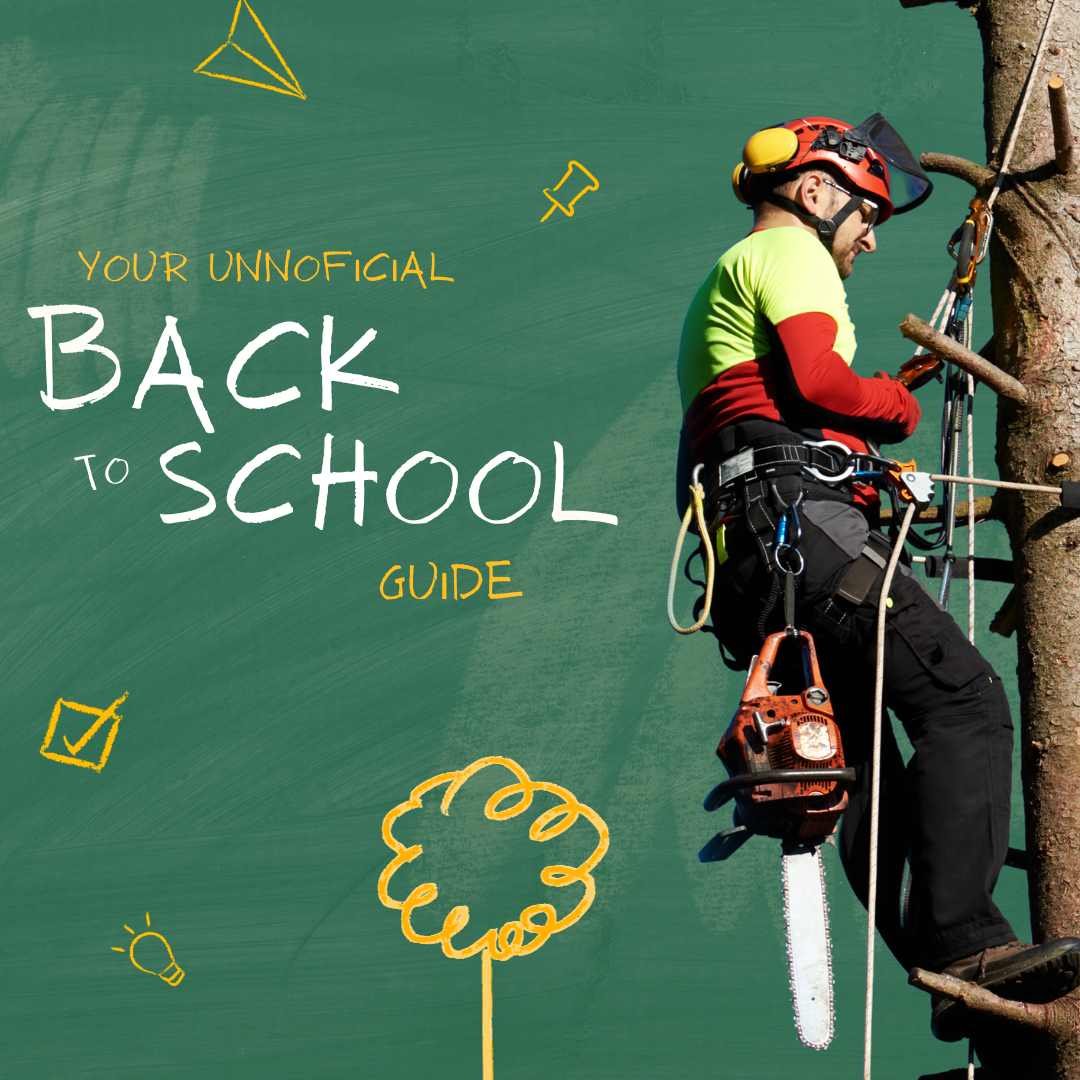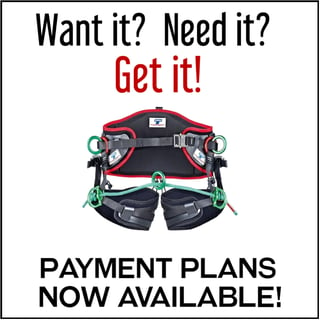Most Recent
Featured Stories

Subscribe To Receive Our Blogs
Popular Stories
Popular Tags
Arborist General Interest Business Arborist Gear Skills Training Events Tree CareYour Unofficial Back to School Guide
Getting ready to go to school this Season? You’ll want to be as prepared as possible so that you can focus on getting the most out of your lessons.
We’ve compiled a brief, but helpful “Back to school” for anyone about to enter an arboriculture Program for the first time.
Find your program information package – Each program is a little bit different, and depending who is putting it on, how it’s funded, and which employers the program caters to, you’ll find each program requires you to come prepared with a different list of stuff. You’ll want to know which pieces of gear the program requires you to bring on your own, and which ones the program provides for you, which are optional to have, and which are mandatory.
If you have any questions about the items on your list, DO NOT hesitate to call your program contact. They would likely prefer to answer your questions before the start of the program rather than once it starts, when they are likely trying to scramble to get everyone else prepares so that they can start with the program lessons!
Quick Clarifications- these are terms you may see on your Gear List. Here we will try to break them down to make them as clear as possible for any of you who may need them clarified. Here is an “unofficial” glossary of terms that might help if you are new to the industry ad your program package contains some terms you aren’t familiar with. Of course, if you still aren’t clear, ASK ASK ASK.
Modifications- Any change made to a piece of gear that isn’t part of the way the item was intended to be used. Examples are – cutting and retying a piece of rope, replacing the webbing in a harness with webbing made by another manufacturer, turning a pair of saw pants in to chaps…
Manufacturers recommendations- Each piece of gear has a corresponding User Manual. In this manual you’ll find extensive information on what is and what isn’t an acceptable use of that piece of gear. If you find you are missing the manual for a piece of gear that you own, search online. Usually, these manuals are available on the manufacturer’s website. If you fail to find one there, contact the retailer, they should have access.
Date of Manufacture- The date that your piece of gear was made- or manufactured. This date is usually found directly ON the piece of gear. You should find the location of this imprint in your User’s Manual.
Suitable working Conditions- We’ve seen a lot of people suddenly “learn” when they enter school that their gear is not in suitable working condition. Gear needs to be retired within the parameters of the manufacturers recommendation (age, discolouration, oxidation on metal, etc.) Make sure there aren’t excessive knicks (if you are wondering if they are excessive, they probably are) any visible rope cores, make sure there are no holes in your boots, or your saw pants. PLEASE don’t let there be any holes that shouldn’t be there in your harness… that kind of stuff.
Hardwear- This refers to any part of your kit that is made of metal- usually Aluminum or steel. Its refers to carabiners, snaps, rings, etc.
Connectors- Connectors are the pieces of hardware that will connect you to the other parts of your gear. They usually open and close, and normally have the function of locking shut. The most common type of connector you will use is a Carabiner.
Spliced eye- A rope that has been sewn or hand spliced to have an “eye” – or loop in it that cannot be undone accidentally or without tools.
Tags-A spliced rope is usually “tagged” with a small label on which vital information is printed. It is usually shrink wrapped to the end of your rope.
Carabiner Snaps- Carabiners.
Knicks and Frays – In a rope, a knik or a fray is any spot that has incurred visible damage. If a strand (a clear group of fibers) in a rope has been severed, that counts as nicks. Fraying is when the strands come unravelled.
Forestry Clips- Also known as lobster snaps, snap clips, etc. These are oblong shaped connectors, usually dual action, that are commonly used as lanyard connectors.
Eye to eye – A short piece or cordage, usually 8-10mm in thickness and usually somewhere between 24” and 32” in length. The friction between this and your climbing line, when the correct hitch is tied, will keep you aloft and allow you to move up and down your line.
High Heat resistance- This usually refers to cordage. Cordage with a high heat resistance can withstand the heat that comes along with friction. Usually, if cordage has a heat resistance it will be stated in the manual or the product description.
Mechanical Hitch- a piece of hardware that is capable of replacing your friction hitch. It would perform the action of ascending, breaking, and descending your climbing line. Examples include: Petzl Zig Zag, Rock Exotica Akimbo, Notch Rope Runner Pro, etc.
Tripple Action, Double Auto Locking Carabiner – In order to be acceptable for climbing, most programs will require the carabiners you use to be Tripple action, meaning the carabiner requires 3 separate motions to be opened. “Autolocking” refers to the fact that when the gate isn’t being manipulated, in will automatically snap into a fully closed and locked position.
Major Axis of a carabiner- The longest “beam” of your Carabiner. Usually, the Carabiner’s ratings are found here. This is the part of carabiner that will be taking the bulk of your weight while you are climbing.
PPE- Personal Protective Equipment. This refers to every part of your gear that serves the purpose of keeping your body parts safe in the event of an accident. Included are: Hard Hat, hearing protection, eye protection, chainsaw protective clothing, safety boots, gloves, highly visible clothing.
Know your gear! Know the name and manufacturer of the gear that you are using. Begin to familiarise yourself with your gear’s acceptable uses, limitations, ratings, and so on. You will likely be quizzed on this, and even if you aren’t, it pays to know what your gear can do!
.jpg?width=6912&height=3456&name=Back%20To%20School%20(1).jpg)
Practice your knots. If your school has given you a list of knots to practice in advance, go ahead and get a head start. Even if you are already used to using these knots, you may find yourself needing to learn to use these knots in a new situation and under pressure. There are many knots you need to learn to climb, and you won’t be allowed to start working aloft until you’ve mastered the basics. It’s wise to start now.
In the event that you haven’t received a list of knots, a quick google of “arborist knots” will do the trick. It isn’t ideal, or exact, but the important part here is that you start familiarizing yourself with the kinds of knots you’ll be trying. It’s better than nothing.
As always, YouTube is FULL of knot tutorials to help you out. The book “Knots at Work” By Jeff Jepson is available at thearboriststore.com, and we’ve even created a few “Knot Spotlight” Reels on Instagram of some of the most basic knots to help you review.
Gather up some warm clothing – Wool Long Johns, good socks, neck warmers, a good thermos… You’ll be spending whole days trekking in the outdoors during the peak of winter. Unlike at work, you won’t have quick access to a truck, and you will likely spend some time standing around listening to your instructors. Other than the odd trip to the bathroom, you’ll be outside the whole time, so make sure you have some way to get warm when you need to. For more on dressing in cold weather see our other blog post: Dressing For Cold Weather.
Save some money – Take it from someone who remembers being panick stricken, calling every day riiiight at 8:00am to hopefully get an update on my financial assistance payments. If you plan on relying on financial assistance to make it through school, please remember that it may take some time, possibly more time than you expect, for your payments to start rolling in. Even if things suddenly get better in that department, it’s better to be safe than sorry!
Get your car in good winter working order-Class will likely occur in several different locations. Often times, these aren’t optimally close to public transport, and there is the potential to need to drive down snowy, icy roads and paths. Don’t get stuck. Make sure your car is in decent working condition and make sure you’ve remembered to put your winter tires on.
That’s it- those are our tips! We wish ever student an enjoyable and informative semester. May you emerge from school a better arborist than you were when you started!
Are you a previous student? Is there something we missed? Let us know in the comments below!



